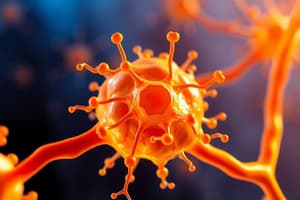Podcast
Questions and Answers
What is the primary function of a receptor in cell signaling?
What is the primary function of a receptor in cell signaling?
- To produce extracellular signal molecules.
- To regulate glucose uptake in endocrine cells.
- To recognize and respond specifically to a signal molecule. (correct)
- To transmit signals through the bloodstream.
In cell signaling, what is the role of kinases?
In cell signaling, what is the role of kinases?
- To transfer phosphate groups from ATP to molecules. (correct)
- To hydrolyze GTP into GDP.
- To remove phosphate groups from molecules.
- To bind GTP and activate signals.
How does GTP binding regulate molecular switches in cells?
How does GTP binding regulate molecular switches in cells?
- GTP binding inhibits a signal, while GDP binding activates it.
- GTP binding activates a signal, while GDP binding inhibits it. (correct)
- GTP and GDP binding both inhibit signals.
- GTP and GDP binding both activate signals.
What distinguishes endocrine signaling from paracrine signaling?
What distinguishes endocrine signaling from paracrine signaling?
Which type of cell signaling involves a cell responding to a signal that it produces itself?
Which type of cell signaling involves a cell responding to a signal that it produces itself?
What is the key feature of neuronal signaling that allows for targeted communication?
What is the key feature of neuronal signaling that allows for targeted communication?
What determines whether a cell exhibits a fast or slow response to a signal?
What determines whether a cell exhibits a fast or slow response to a signal?
What is the consequence of a cell stopping receiving appropriate signals?
What is the consequence of a cell stopping receiving appropriate signals?
Which of the following molecules can act as extracellular signals?
Which of the following molecules can act as extracellular signals?
What is the defining characteristic of contact-dependent signaling?
What is the defining characteristic of contact-dependent signaling?
Why can't most chemical signaling molecules cross the cell membrane?
Why can't most chemical signaling molecules cross the cell membrane?
How do cell-surface receptors facilitate signal transduction?
How do cell-surface receptors facilitate signal transduction?
What is the role of G-proteins in cell signaling?
What is the role of G-proteins in cell signaling?
How can the active time of G-protein components be determined?
How can the active time of G-protein components be determined?
What typically results from activation of membrane-bound enzymes by G proteins?
What typically results from activation of membrane-bound enzymes by G proteins?
Which of the following describes the function of adenylyl cyclase?
Which of the following describes the function of adenylyl cyclase?
How do signals lead to a change affecting heart rate?
How do signals lead to a change affecting heart rate?
What is the main function of receptor tyrosine kinases (RTKs)?
What is the main function of receptor tyrosine kinases (RTKs)?
What process is often triggered by the binding of an extracellular signal to receptor tyrosine kinases (RTKs)?
What process is often triggered by the binding of an extracellular signal to receptor tyrosine kinases (RTKs)?
In active RTKs, what is the function of the newly phosphorylated tyrosines?
In active RTKs, what is the function of the newly phosphorylated tyrosines?
Flashcards
Signal transduction
Signal transduction
Conversion of one signal into another form.
Receptors
Receptors
Proteins on target cells that detect specific signals.
Endocrine cells
Endocrine cells
Cells that produce hormones that regulate glucose uptake.
Paracrine signaling
Paracrine signaling
Signup and view all the flashcards
Phosphorylation
Phosphorylation
Signup and view all the flashcards
Protein Kinases
Protein Kinases
Signup and view all the flashcards
GTP
GTP
Signup and view all the flashcards
Exocytosis
Exocytosis
Signup and view all the flashcards
Signal Response
Signal Response
Signup and view all the flashcards
Permanent response
Permanent response
Signup and view all the flashcards
NGF (Nerve Growth Factor)
NGF (Nerve Growth Factor)
Signup and view all the flashcards
Endocrine signaling
Endocrine signaling
Signup and view all the flashcards
Autocrine Signaling
Autocrine Signaling
Signup and view all the flashcards
Neuronal Signaling
Neuronal Signaling
Signup and view all the flashcards
Contact-dependent Signaling
Contact-dependent Signaling
Signup and view all the flashcards
Extracellular Signals
Extracellular Signals
Signup and view all the flashcards
Receptors
Receptors
Signup and view all the flashcards
Cell membrane embedded receptors
Cell membrane embedded receptors
Signup and view all the flashcards
Specific ligand binding
Specific ligand binding
Signup and view all the flashcards
G-Proteins
G-Proteins
Signup and view all the flashcards
Study Notes
Principles of Cell Signaling
- Signal transduction involves converting one signal into another within a cell
- This process starts when an extracellular signal is received by a receptor, leading to intracellular signaling and altered cell behavior
- Cell communication involves a signaling cell producing an extracellular signal molecule, which is detected by a target cell.
- Target cells use receptors to recognize and respond to specific signal molecules
Types of Signal Molecules
- Cells communicate using various extracellular signal molecules, including proteins, amino acids, nucleotides, steroids, fatty acid derivatives, and dissolved gases
- Hormones: Extracellular signaling molecules transmitted throughout the body via the bloodstream
- Endocrine cells (e.g., in the pancreas): Produce hormones like insulin, regulating glucose uptake
- Paracrine signaling: Signal diffusion occurs locally through extracellular fluid
Intracellular Signaling Processes
- Proteins act as molecular switches, activated or deactivated by adding or removing molecules or energy
- Phosphorylation: Activation or inactivation occurs when a phosphate group is covalently bound or cleaved, protein kinases transfer a phosphate group from ATP to serine, threonine, or tyrosine residues
- GTP binding: Activation occurs when bound to GTP and inactivation when bound to GDP
Cell-Cell Communication Basics
- A signaling molecule is produced, typically via exocytosis
- The signaling molecule is transported to the target cell
- The target cell receptor binds the signaling molecule to receive the signal
- The target cell responds, altering its behavior
Signal Response Variations
- Responses can be fast (seconds to minutes) or slow (minutes to hours)
- Fast Response: Involves pre-existing proteins and alters their activity
- Slow Response: Requires new synthesis, transcription, or translation, leading to changes in gene expression and protein synthesis
Duration of Cell Response
- Cell responses can be transient or permanent
- Transient: Can revert back
- Permanent: Cannot revert back
Nerve Growth Factor (NGF)
- Peptide hormones serve as signaling molecules
- NGF is secreted by organs to attract innervating neurons.
- Sympathetic neurons grow towards the NGF source
- Rita Levi-Montalcini discovered NGF in the 1950s.
- Sympathetic neurons die without NGF signals
Cell Information Processing
- Cells integrate multiple signals to fine-tune responses
- Apoptosis occurs if appropriate signals are absent or inhibited
- Apoptosis prevents poorly functioning cells from surviving (programmed cell death)
Receptors & Signaling molecules
- Cells employ diverse chemical signals, including proteins, peptides, amino acids, nucleotides, and even gases
- Environmental information is also detected via receptors, such as, mechanoreceptors (physical pressure), photoreceptors (light), voltage-gated ion channels (electrical stimulus), and TRP channels (temperature)
Signal Distances
- Endocrine (Public): Long Distance, Hormones are released into the bloodstream for widespread distribution
- Paracrine (Local): Local mediator to talks to a different cell via the extracellular matrix
- Autocrine (Self-Signaling): The cell responds to its own signal through negative feedback, regulating its activity
Specific Cell Targeting
- Neuronal: Specialized paracrine signaling where neurotransmitters are secreted into small synapses
- Neurotransmitters are quickly removed from the synapse, and the cell response depends on the signaling molecule's half-life
- Signaling molecules with quick degradation lead to fast responses, while persistent molecules generate slower responses
Contact-Dependent (Juxtacrine) Signaling
- Requires direct cell contact, either extracellularly via membrane-bound signals or intracellularly via direct cytoplasm connections
- Plasmodesmata in plant cells establish connections
Gap Junctions
- Clusters of intercellular channels allow direct diffusion of ions and small molecules between adjacent cells
- In cardiomyocytes, gap junctions enable rapid action potential spread
Signal Transduction
- Signaling molecules that can't cross cell membranes are large or hydrophilic
- Extracellular receptors are used in the cell membrane for signal-to-cell surface communication
Types of Extracellular Receptors
- Ligand-gated ion channels, G-protein coupled receptors, enzyme-linked receptors
Ligand-Gated Ion Channels
- Ions alter membrane potential and trigger an action potential
- Signal molecules bind, causing conformational change
G-Protein Coupled Receptors (GPCRs)
- Form the largest family of surface receptors and have a similar structure
- GPCRs interact with G-proteins, which have three subunits: α, β, and γ
- GTP-binding proteins (GTP and GDP) act as molecular switches
- α and γ subunits are tethered to the membrane, can have inactivation or activation states
G-Protein Regulation
- Regulated by binding either GTP (active) or GDP (inactive), controlled by regulatory proteins such as GEF and GAP
- Trimeric G proteins relay messages from G-receptors
G-Protein Coupled Receptors
- Upon activation, a G-protein exchanges GDP for GTP, separating into α subunit and βγ complex
- Both components interact with target proteins, with the α subunit binding to other enzymes
- Active time is determined by how long the α subunit holds onto GTP
- G-proteins can regulate ion channels or activate membrane-bound enzymes
Frequent targets for enzyme regulation
- Adenylyl cyclase: Produces cyclic AMP (cAMP)
- Phospholipase C: Produces inositol trisphosphate and diacylglycerol
Acetylcholine effects study notes
- Nerve signals slow heart rate by releasing acetylcholine
- Acetylcholine binds to GPCR, activating the G-protein
- The βγ complex binds to the intracellular face of the K+ channel, opening it
Action Potential Review
- Membrane potential reversal mediates electrical signaling
- Resting membrane potential: ~ -70 mV
- Neurotransmitters can cause depolarization: Membrane becomes less polarized, moving closer to 0 mV
Enzyme-Linked Receptors
- Includes enzyme complexes or enzyme-associated receptors
- Direct intracellular effects differ from GPCRs
- Receptor Tyrosine Kinases (RTKs) has a cytosolic domain phosphorylates tyrosines on intracellular signaling proteins
- Catalytic domain needs binding by an enzyme (direct contact or touch) for activation
Receptor Tyrosine Kinases (RTKs)
- Binding of an extracellular signal often causes two receptors to form a dimer
- Each receptor tail phosphorylates the other, activating kinase domains
- Phosphorylated tyrosines serve as docking sites for intracellular signaling proteins
- Signal complex remains active unless halted by a phosphatase or endocytosis
Studying That Suits You
Use AI to generate personalized quizzes and flashcards to suit your learning preferences.



